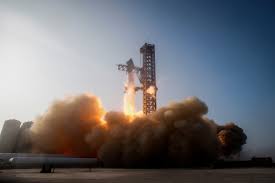
SpaceX, the private aerospace company founded by Elon Musk, has been at the forefront of advancing space technology. The Starship project, aimed at creating the world’s most powerful launch vehicle, has generated global interest. This comprehensive article explores the latest developments in the SpaceX Starship test, its objectives, the challenges faced, and its potential impact on the future of space exploration.
Overview of the SpaceX Starship Project
The Starship is a fully reusable spacecraft being developed by SpaceX for missions to the Moon, Mars, and beyond. It consists of two stages: the Super Heavy booster and the Starship spacecraft. Designed to be the most powerful rocket ever built, it can carry up to 100 tons of cargo and crew. The project has been seen as key to fulfilling SpaceX’s long-term goal of enabling human life on other planets.
The Latest Starship Test: A Milestone Event
In 2024, SpaceX conducted its latest Starship test to assess the capabilities of the spacecraft’s design, especially in terms of reusability and overall performance. The test involved launching the Starship prototype, separating the spacecraft from the booster, and attempting a controlled descent and landing. Each test builds on previous iterations, providing data to improve future missions.
Key Objectives of the Test
The primary objectives of the recent Starship test include:
Testing the Super Heavy booster’s performance during launch.
Evaluating the Starship’s heat shield and durability during atmospheric reentry.
Assessing the landing systems, including flip maneuvers, to ensure safe and reusable operations.
Collecting critical data to refine aerodynamic control and fuel efficiency.
These objectives are crucial as SpaceX pushes toward a fully functional, reusable system that can return from deep space missions and be reused for multiple flights.
Challenges Faced in Starship Testing
While SpaceX has made incredible progress with the Starship, it has faced numerous technical challenges. Some key issues during tests include:
Raptor engine failures: The highly complex and powerful Raptor engines have experienced shutdowns and explosions during some test flights.
Landing failures: In several tests, Starship prototypes have failed to land intact, either due to velocity control issues or improper alignment during descent.
Heat shield performance: The spacecraft’s heat shield must withstand extreme temperatures during reentry. Past tests have shown that some portions of the shield may need further refinement.
Despite these setbacks, each test provides valuable insights that SpaceX engineers use to improve the design for future missions.
The Significance of Success in the Starship Program
The success of the Starship test would mark a significant leap in the development of space travel technology. Here’s why:
Deep Space Missions: A fully operational Starship could revolutionize space travel by making missions to the Moon and Mars feasible and cost-effective.
Commercial Payloads: Starship’s payload capacity opens the door to launching large commercial satellites, space stations, and scientific equipment for deep space exploration.
Space Tourism: Musk has frequently spoken about using Starship for commercial space tourism, taking civilians on orbital flights or even to the Moon.
Impact on Mars Colonization
One of Elon Musk’s boldest aspirations for Starship is the colonization of Mars. The reusable rocket system is envisioned as a means of transporting large numbers of people and cargo to the Red Planet, making sustained habitation possible. The success of the Starship test program is a crucial step toward realizing this goal.
Looking Ahead: Future SpaceX Starship Tests
Following the success and setbacks of recent Starship tests, SpaceX plans to continue refining the vehicle. Future tests are expected to include orbital flights, tests of the refueling process in space, and landing trials on the Moon’s surface. SpaceX has also secured NASA contracts to use Starship as part of the Artemis program, which aims to return humans to the Moon by 2025.
A New Era of Space Exploration
The SpaceX Starship test represents more than just a technological demonstration; it symbolizes a new era of space exploration, where reusable spacecraft could dramatically reduce the cost of interplanetary travel. While challenges remain, the potential of Starship to transform humanity’s future in space is immense. Whether enabling human missions to Mars or launching commercial payloads, SpaceX continues to push the boundaries of what is possible, paving the way for a future where space travel is accessible on an unprecedented scale.
Subscribe to Follow Global Trends for daily global news.
Find Out How To Make Money As A Full Time Writer/Blogger Guide.
To Advertise, Advertise Your Affiliate Links on FollowGlobalTrends.com for Just $1 Per Link Per Month!
Related Articles
Written By: Enyoghasi Ngozi pricillia
,

